Svitlana Vakulenko
Retrieving Contextual Information for Long-Form Question Answering using Weak Supervision
Oct 11, 2024Abstract:Long-form question answering (LFQA) aims at generating in-depth answers to end-user questions, providing relevant information beyond the direct answer. However, existing retrievers are typically optimized towards information that directly targets the question, missing out on such contextual information. Furthermore, there is a lack of training data for relevant context. To this end, we propose and compare different weak supervision techniques to optimize retrieval for contextual information. Experiments demonstrate improvements on the end-to-end QA performance on ASQA, a dataset for long-form question answering. Importantly, as more contextual information is retrieved, we improve the relevant page recall for LFQA by 14.7% and the groundedness of generated long-form answers by 12.5%. Finally, we show that long-form answers often anticipate likely follow-up questions, via experiments on a conversational QA dataset.
Beyond Relevant Documents: A Knowledge-Intensive Approach for Query-Focused Summarization using Large Language Models
Aug 19, 2024Abstract:Query-focused summarization (QFS) is a fundamental task in natural language processing with broad applications, including search engines and report generation. However, traditional approaches assume the availability of relevant documents, which may not always hold in practical scenarios, especially in highly specialized topics. To address this limitation, we propose a novel knowledge-intensive approach that reframes QFS as a knowledge-intensive task setup. This approach comprises two main components: a retrieval module and a summarization controller. The retrieval module efficiently retrieves potentially relevant documents from a large-scale knowledge corpus based on the given textual query, eliminating the dependence on pre-existing document sets. The summarization controller seamlessly integrates a powerful large language model (LLM)-based summarizer with a carefully tailored prompt, ensuring the generated summary is comprehensive and relevant to the query. To assess the effectiveness of our approach, we create a new dataset, along with human-annotated relevance labels, to facilitate comprehensive evaluation covering both retrieval and summarization performance. Extensive experiments demonstrate the superior performance of our approach, particularly its ability to generate accurate summaries without relying on the availability of relevant documents initially. This underscores our method's versatility and practical applicability across diverse query scenarios.
Scene-centric vs. Object-centric Image-Text Cross-modal Retrieval: A Reproducibility Study
Jan 12, 2023Abstract:Most approaches to cross-modal retrieval (CMR) focus either on object-centric datasets, meaning that each document depicts or describes a single object, or on scene-centric datasets, meaning that each image depicts or describes a complex scene that involves multiple objects and relations between them. We posit that a robust CMR model should generalize well across both dataset types. Despite recent advances in CMR, the reproducibility of the results and their generalizability across different dataset types has not been studied before. We address this gap and focus on the reproducibility of the state-of-the-art CMR results when evaluated on object-centric and scene-centric datasets. We select two state-of-the-art CMR models with different architectures: (i) CLIP; and (ii) X-VLM. Additionally, we select two scene-centric datasets, and three object-centric datasets, and determine the relative performance of the selected models on these datasets. We focus on reproducibility, replicability, and generalizability of the outcomes of previously published CMR experiments. We discover that the experiments are not fully reproducible and replicable. Besides, the relative performance results partially generalize across object-centric and scene-centric datasets. On top of that, the scores obtained on object-centric datasets are much lower than the scores obtained on scene-centric datasets. For reproducibility and transparency we make our source code and the trained models publicly available.
Focusing on Context is NICE: Improving Overshadowed Entity Disambiguation
Oct 12, 2022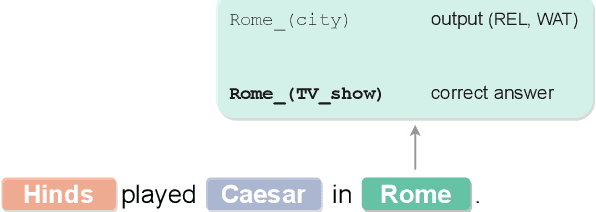
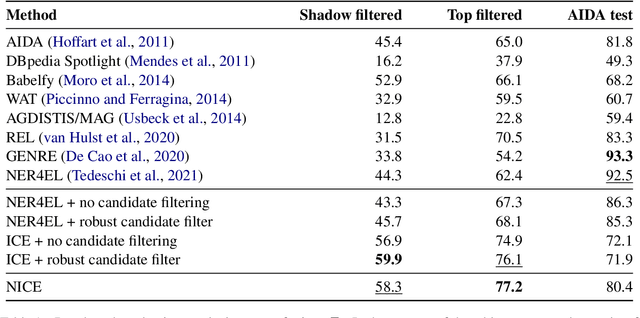
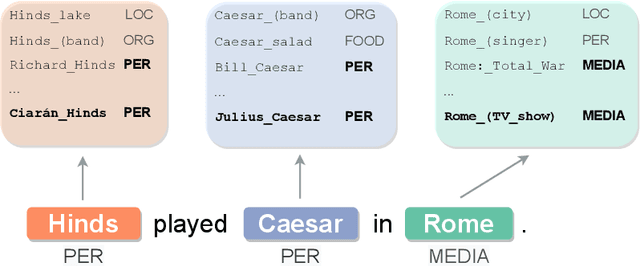
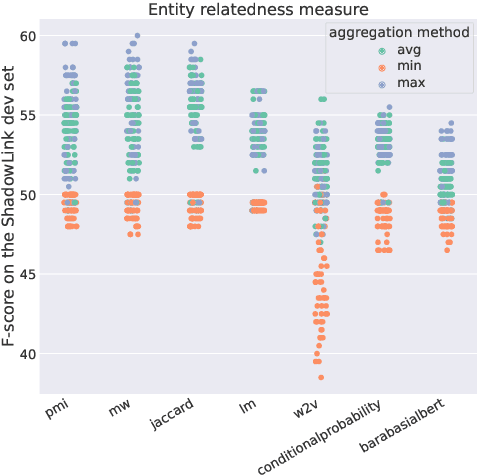
Abstract:Entity disambiguation (ED) is the task of mapping an ambiguous entity mention to the corresponding entry in a structured knowledge base. Previous research showed that entity overshadowing is a significant challenge for existing ED models: when presented with an ambiguous entity mention, the models are much more likely to rank a more frequent yet less contextually relevant entity at the top. Here, we present NICE, an iterative approach that uses entity type information to leverage context and avoid over-relying on the frequency-based prior. Our experiments show that NICE achieves the best performance results on the overshadowed entities while still performing competitively on the frequent entities.
On the Impact of Speech Recognition Errors in Passage Retrieval for Spoken Question Answering
Sep 26, 2022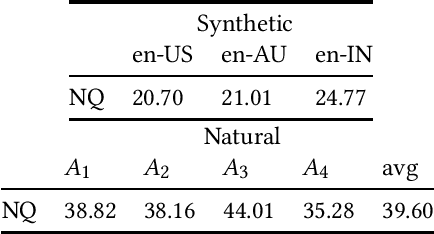



Abstract:Interacting with a speech interface to query a Question Answering (QA) system is becoming increasingly popular. Typically, QA systems rely on passage retrieval to select candidate contexts and reading comprehension to extract the final answer. While there has been some attention to improving the reading comprehension part of QA systems against errors that automatic speech recognition (ASR) models introduce, the passage retrieval part remains unexplored. However, such errors can affect the performance of passage retrieval, leading to inferior end-to-end performance. To address this gap, we augment two existing large-scale passage ranking and open domain QA datasets with synthetic ASR noise and study the robustness of lexical and dense retrievers against questions with ASR noise. Furthermore, we study the generalizability of data augmentation techniques across different domains; with each domain being a different language dialect or accent. Finally, we create a new dataset with questions voiced by human users and use their transcriptions to show that the retrieval performance can further degrade when dealing with natural ASR noise instead of synthetic ASR noise.
Low-Resource Dense Retrieval for Open-Domain Question Answering: A Comprehensive Survey
Aug 05, 2022

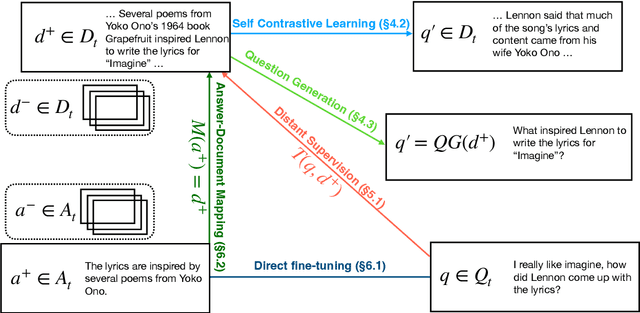
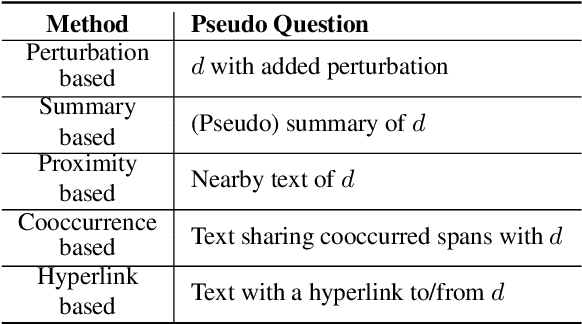
Abstract:Dense retrieval (DR) approaches based on powerful pre-trained language models (PLMs) achieved significant advances and have become a key component for modern open-domain question-answering systems. However, they require large amounts of manual annotations to perform competitively, which is infeasible to scale. To address this, a growing body of research works have recently focused on improving DR performance under low-resource scenarios. These works differ in what resources they require for training and employ a diverse set of techniques. Understanding such differences is crucial for choosing the right technique under a specific low-resource scenario. To facilitate this understanding, we provide a thorough structured overview of mainstream techniques for low-resource DR. Based on their required resources, we divide the techniques into three main categories: (1) only documents are needed; (2) documents and questions are needed; and (3) documents and question-answer pairs are needed. For every technique, we introduce its general-form algorithm, highlight the open issues and pros and cons. Promising directions are outlined for future research.
A Simple Contrastive Learning Objective for Alleviating Neural Text Degeneration
May 19, 2022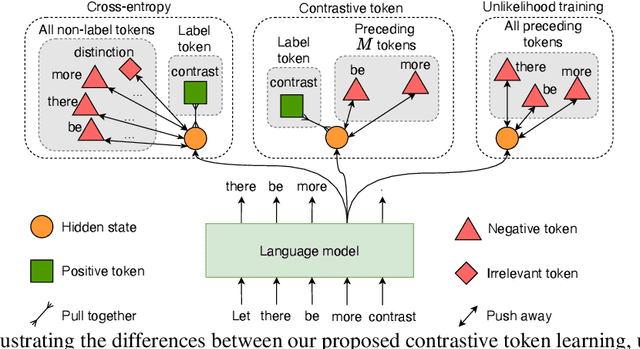

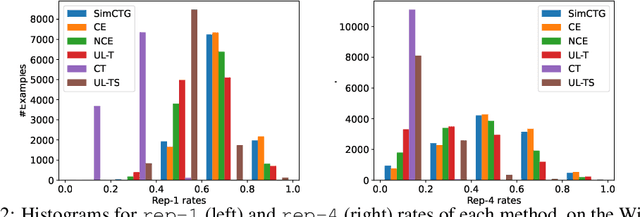
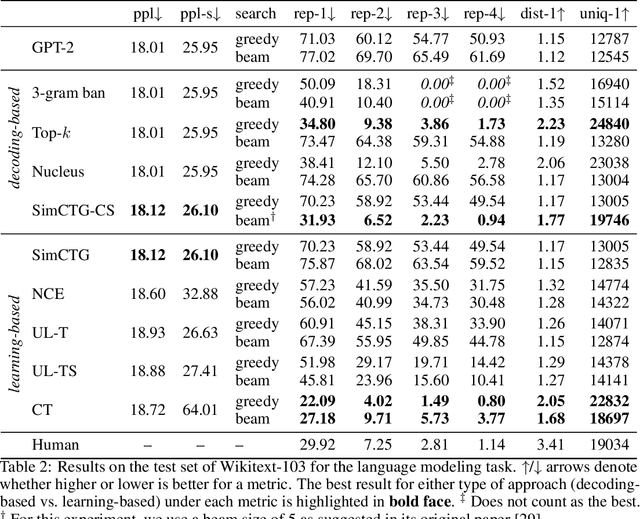
Abstract:The cross-entropy objective has proved to be an all-purpose training objective for autoregressive language models (LMs). However, without considering the penalization of problematic tokens, LMs trained using cross-entropy exhibit text degeneration. To address this, unlikelihood training has been proposed to reduce the probability of unlikely tokens predicted by LMs. But unlikelihood does not consider the relationship between the label tokens and unlikely token candidates, thus showing marginal improvements in degeneration. We propose a new contrastive token learning objective that inherits the advantages of cross-entropy and unlikelihood training and avoids their limitations. The key idea is to teach a LM to generate high probabilities for label tokens and low probabilities of negative candidates. Comprehensive experiments on language modeling and open-domain dialogue generation tasks show that the proposed contrastive token objective yields much less repetitive texts, with a higher generation quality than baseline approaches, achieving the new state-of-the-art performance on text degeneration.
SCAI-QReCC Shared Task on Conversational Question Answering
Jan 26, 2022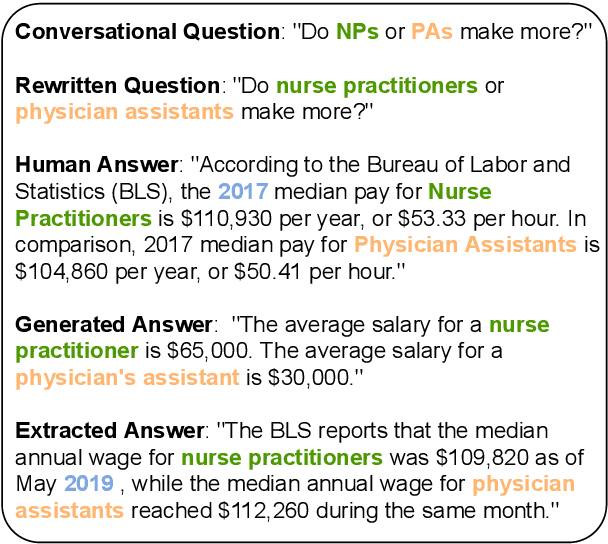
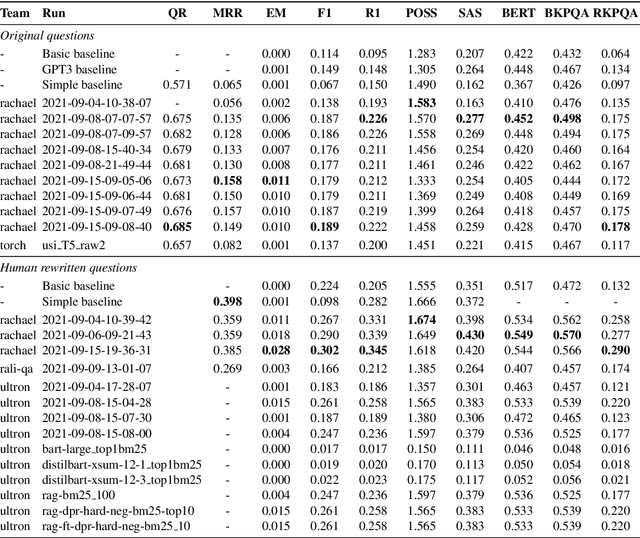
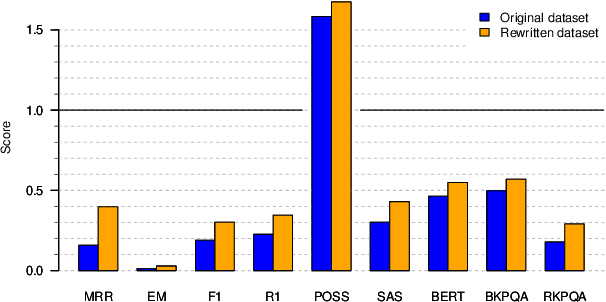
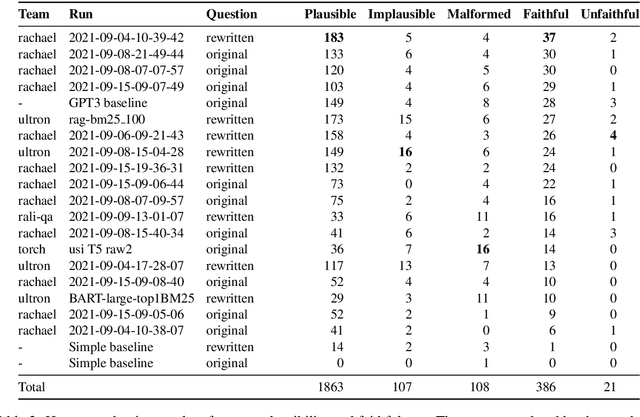
Abstract:Search-Oriented Conversational AI (SCAI) is an established venue that regularly puts a spotlight upon the recent work advancing the field of conversational search. SCAI'21 was organised as an independent on-line event and featured a shared task on conversational question answering. Since all of the participant teams experimented with answer generation models for this task, we identified evaluation of answer correctness in this settings as the major challenge and a current research gap. Alongside the automatic evaluation, we conducted two crowdsourcing experiments to collect annotations for answer plausibility and faithfulness. As a result of this shared task, the original conversational QA dataset used for evaluation was further extended with alternative correct answers produced by the participant systems.
Extending CLIP for Category-to-image Retrieval in E-commerce
Jan 04, 2022
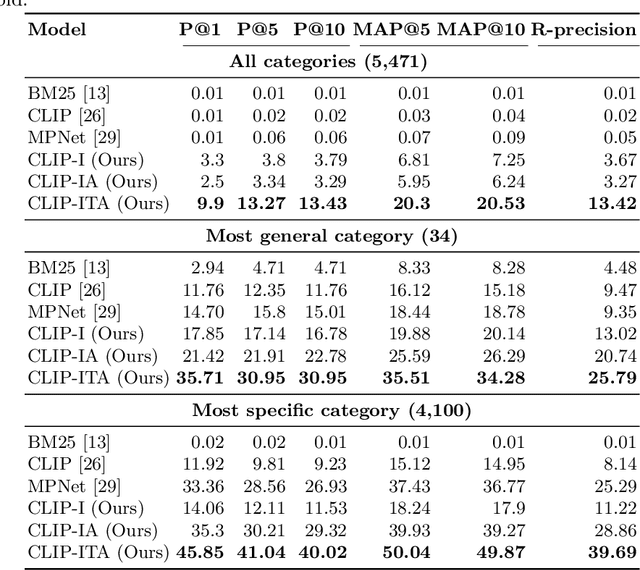
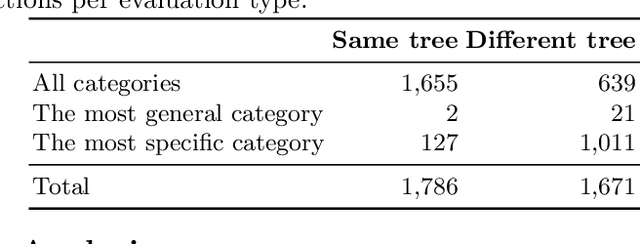

Abstract:E-commerce provides rich multimodal data that is barely leveraged in practice. One aspect of this data is a category tree that is being used in search and recommendation. However, in practice, during a user's session there is often a mismatch between a textual and a visual representation of a given category. Motivated by the problem, we introduce the task of category-to-image retrieval in e-commerce and propose a model for the task, CLIP-ITA. The model leverages information from multiple modalities (textual, visual, and attribute modality) to create product representations. We explore how adding information from multiple modalities (textual, visual, and attribute modality) impacts the model's performance. In particular, we observe that CLIP-ITA significantly outperforms a comparable model that leverages only the visual modality and a comparable model that leverages the visual and attribute modality.
Scaling Up Query-Focused Summarization to Meet Open-Domain Question Answering
Dec 14, 2021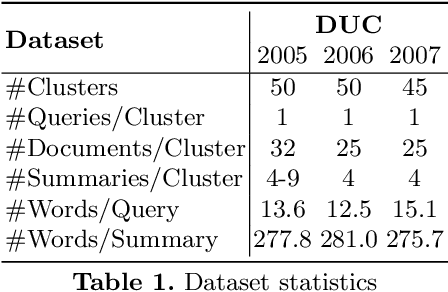
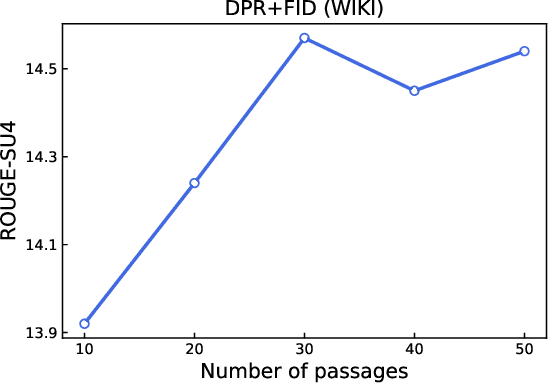
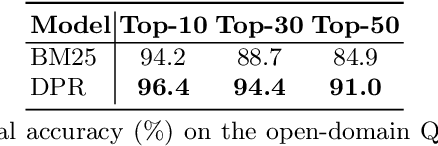
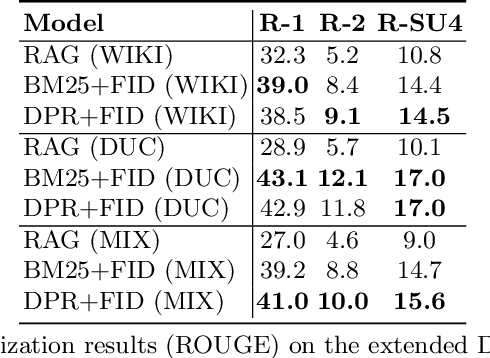
Abstract:Query-focused summarization (QFS) requires generating a textual summary given a query using a set of relevant documents. However, in practice, such relevant documents are not readily available but should be first retrieved from a document collection. Therefore, we show how to extend this task to make it more realistic. Thereby the task setup also resembles the settings of the open-domain question answering task, where the answer is a summary of the top-retrieved documents. To address this extended task, we combine passage retrieval with text generation to produce the summary of the retrieved passages given the input query. We demonstrate the first evaluation results on the proposed task and show that a few samples are sufficient to fine-tune a large generative model with retrieved passages.
 Add to Chrome
Add to Chrome Add to Firefox
Add to Firefox Add to Edge
Add to Edge